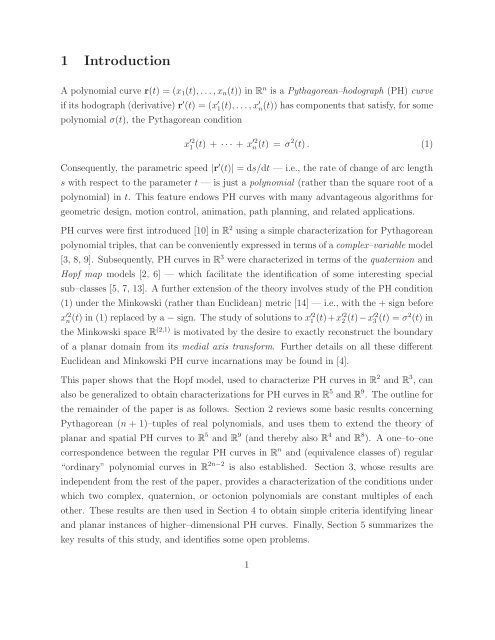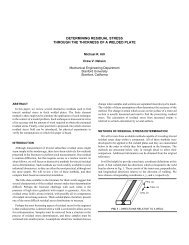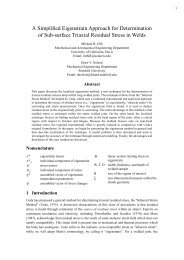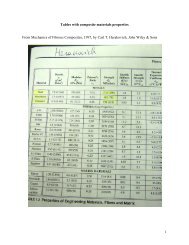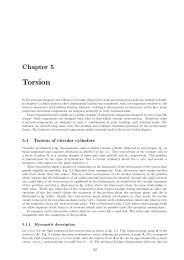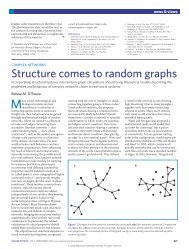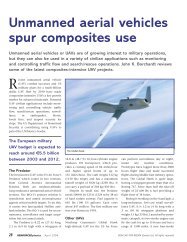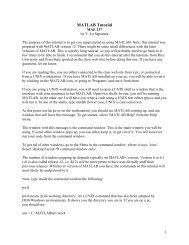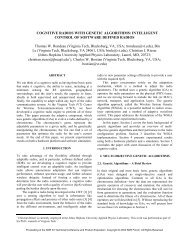Pythagorean-hodograph curves in Euclidean spaces of dimension ...
Pythagorean-hodograph curves in Euclidean spaces of dimension ...
Pythagorean-hodograph curves in Euclidean spaces of dimension ...
Create successful ePaper yourself
Turn your PDF publications into a flip-book with our unique Google optimized e-Paper software.
1 Introduction<br />
A polynomial curve r(t) = (x1(t), . . .,xn(t)) <strong>in</strong> R n is a <strong>Pythagorean</strong>–<strong>hodograph</strong> (PH) curve<br />
if its <strong>hodograph</strong> (derivative) r ′ (t) = (x ′ 1(t), . . .,x ′ n(t)) has components that satisfy, for some<br />
polynomial σ(t), the <strong>Pythagorean</strong> condition<br />
x ′2<br />
1 (t) + · · · + x′2 n (t) = σ2 (t) . (1)<br />
Consequently, the parametric speed |r ′ (t)| = ds/dt — i.e., the rate <strong>of</strong> change <strong>of</strong> arc length<br />
s with respect to the parameter t — is just a polynomial (rather than the square root <strong>of</strong> a<br />
polynomial) <strong>in</strong> t. This feature endows PH <strong>curves</strong> with many advantageous algorithms for<br />
geometric design, motion control, animation, path plann<strong>in</strong>g, and related applications.<br />
PH <strong>curves</strong> were first <strong>in</strong>troduced [10] <strong>in</strong> R 2 us<strong>in</strong>g a simple characterization for <strong>Pythagorean</strong><br />
polynomial triples, that can be conveniently expressed <strong>in</strong> terms <strong>of</strong> a complex–variable model<br />
[3, 8, 9]. Subsequently, PH <strong>curves</strong> <strong>in</strong> R 3 were characterized <strong>in</strong> terms <strong>of</strong> the quaternion and<br />
Hopf map models [2, 6] — which facilitate the identification <strong>of</strong> some <strong>in</strong>terest<strong>in</strong>g special<br />
sub–classes [5, 7, 13]. A further extension <strong>of</strong> the theory <strong>in</strong>volves study <strong>of</strong> the PH condition<br />
(1) under the M<strong>in</strong>kowski (rather than <strong>Euclidean</strong>) metric [14] — i.e., with the + sign before<br />
x ′2 n (t) <strong>in</strong> (1) replaced by a − sign. The study <strong>of</strong> solutions to x′2 1 (t)+x′2 2 (t)−x′2 3 (t) = σ2 (t) <strong>in</strong><br />
the M<strong>in</strong>kowski space R (2,1) is motivated by the desire to exactly reconstruct the boundary<br />
<strong>of</strong> a planar doma<strong>in</strong> from its medial axis transform. Further details on all these different<br />
<strong>Euclidean</strong> and M<strong>in</strong>kowski PH curve <strong>in</strong>carnations may be found <strong>in</strong> [4].<br />
This paper shows that the Hopf model, used to characterize PH <strong>curves</strong> <strong>in</strong> R 2 and R 3 , can<br />
also be generalized to obta<strong>in</strong> characterizations for PH <strong>curves</strong> <strong>in</strong> R 5 and R 9 . The outl<strong>in</strong>e for<br />
the rema<strong>in</strong>der <strong>of</strong> the paper is as follows. Section 2 reviews some basic results concern<strong>in</strong>g<br />
<strong>Pythagorean</strong> (n + 1)–tuples <strong>of</strong> real polynomials, and uses them to extend the theory <strong>of</strong><br />
planar and spatial PH <strong>curves</strong> to R 5 and R 9 (and thereby also R 4 and R 8 ). A one–to–one<br />
correspondence between the regular PH <strong>curves</strong> <strong>in</strong> R n and (equivalence classes <strong>of</strong>) regular<br />
“ord<strong>in</strong>ary” polynomial <strong>curves</strong> <strong>in</strong> R 2n−2 is also established. Section 3, whose results are<br />
<strong>in</strong>dependent from the rest <strong>of</strong> the paper, provides a characterization <strong>of</strong> the conditions under<br />
which two complex, quaternion, or octonion polynomials are constant multiples <strong>of</strong> each<br />
other. These results are then used <strong>in</strong> Section 4 to obta<strong>in</strong> simple criteria identify<strong>in</strong>g l<strong>in</strong>ear<br />
and planar <strong>in</strong>stances <strong>of</strong> higher–<strong>dimension</strong>al PH <strong>curves</strong>. F<strong>in</strong>ally, Section 5 summarizes the<br />
key results <strong>of</strong> this study, and identifies some open problems.<br />
1


